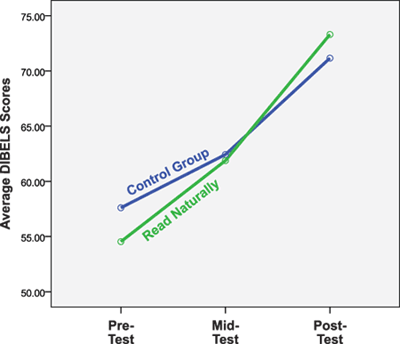Reviews of Read Naturally
University Study of Read Naturally Gets High Rating From NCII
The National Center on Intensive Intervention (NCII) has given a University of Minnesota study of Read Naturally high marks for study quality.
The study, conducted by Associate Professor Theodore Christ, Ph.D., and Jennifer Davie, found that students using Read Naturally Software Edition had 39% greater gains in fluency than students in a control group.
The NCII was established by the American Institutes for Research (AIR) and researchers from the University of Kansas and Vanderbilt University to provide technical assistance to states and districts in implementing RTI and Early Intervening Services (EIS). NCII receives funding from the U.S. Department of Education.
One of the NCII’s activities is a rigorous technical review to determine which tools, practices, and implementation strategies are deemed scientifically valid and appropriate for technical assistance and dissemination.
 NCII Reviews of Intervention Studies
NCII Reviews of Intervention Studies
The NCII concluded that the Christ & Davie study of Read Naturally provided convincing evidence in four criteria—design, fidelity of implementation, measures (targeted), and measures (broader), as shown in the following table:
| Study | Study Quality | |||
|---|---|---|---|---|
| Design | Fidelity of Implementation | Measures (Targeted) | Measures (Broader) | |
| Christ & Davie Study of Read Naturally |  |  |  |  |
Key:  Convincing evidence
Convincing evidence  Partially convincing evidence
Partially convincing evidence  Unconvincing evidence
Unconvincing evidence
About the Christ & Davie Study
The Christ & Davie study was a randomized control trial that was conducted in late 2008 and early 2009 across six schools with 109 low-performing students in third grade. Those students assigned to the Read Naturally group received intervention instruction for 30 minutes per day, five days a week, for 10 weeks. Students in the control group received normal classroom reading instruction with no supplemental fluency instruction.
Multiple standardized measures of reading accuracy and fluency indicated that students in the Read Naturally group outperformed students in the control group on all measures of accuracy and fluency.
The study examined the students’ fluency gains using results from Dynamic Indicators of Basic Early Literacy Skills (DIBELS) assessments. The Read Naturally students gained, on average, 1.53 WRC/min per week compared to 1.10 WRC/min per week for students in the control group—39% greater gains for students in the Read Naturally group.
Figure 1 illustrates that the DIBELS average for the Read Naturally group was below that of the control group at pre-test, and after 10 weeks of intervention, the Read Naturally students outperformed those in the control group.

Figure 1. Chart Comparing Average DIBELS Scores
Over the Course of the 10-Week Study
Students in the Read Naturally group gained, on average, .40 WRC/min more than students in the control group. The magnitude of improvement should be compared to typical growth and expected levels of achievement among third-grade students. Published estimates of typical growth in third grade approximate 1.2 WRC/min among students in general education and .58 WRC/min among students in special education. Students are expected to exceed 100 WRC/min by the end of the third grade if they are to be successful on large scale state-wide assessments. A sustained additional improvement of .40 WRC/min across the academic year is substantial. Assuming a typical growth rate of approximately 1.20 WRC/min per week, a 39% improvement would result in improved growth to 1.68 WRC/min per week, which is a cumulative gain of 14.4 more words read correct across 36 weeks.
These results were not specific to DIBELS measures. After accounting for pre-test levels of performance, the students in the Read Naturally group scored one to two standard score units better on most standardized measures of fluency and accuracy after 10 weeks of intervention. If extrapolated across the school year, those gains would translate to approximately three to seven standard score units of improved performance for those students within the Read Naturally group compared to the control group. Such improvements would be substantial.
 Complete results of the Christ & Davie study
Complete results of the Christ & Davie study
Other Read Naturally Studies Reviewed by NCII
The NCII has also reviewed two other Read Naturally studies. Dr. Dave Heistad’s 2004 study demonstrated that Read Naturally has a substantial and academically meaningful long-term impact on broad, high-stakes comprehension measures like the Minnesota Comprehensive Assessments (MCA). A study by Christine Tucker of Walden University and Don Jones of Texas A&M University – Kingsville demonstrated that students who received Read Naturally instruction as a supplementary intervention made substantially more gains in fluency, accuracy, and rate than students in a control group.
 Learn more about the Heistad study
Learn more about the Heistad study
 Learn more about the Tucker & Jones study
Learn more about the Tucker & Jones study
Additional Studies and Reviews
Overview of Additional Studies and Reviews
Additional Read Naturally Strategy Studies
- Nickodem, K. and Dupuis, D. (2017): New findings on Read Naturally Live
- Heistad, D. (2004): The effects of Read Naturally on fluency and reading comprehension (two-school study)
- Johnson, G. and Weaver, J.: Special education students, grades 3 through 8, Huron County, MI
- Ihnot, C. and Marston, D. (1990): Using teacher modeling and repeated reading to improve the reading performance of mildly handicapped students
Reviews of Read Naturally
- University Study of Read Naturally Gets High Rating From NCII
- FCRR and U of Oregon Give Read Naturally Highest Ratings
- Chart Comparing WWC, FCRR, University of Oregon, and NCRTI
- Hancock Study Author States Study Was Not Intended to Evaluate Read Naturally
- Review of Kemp Study Deceives Educators
Word Warm-ups Studies
Take Aim at Vocabulary Studies
Please let us know what questions you have so we can assist. For Technical Support, please call us or submit a software support request.